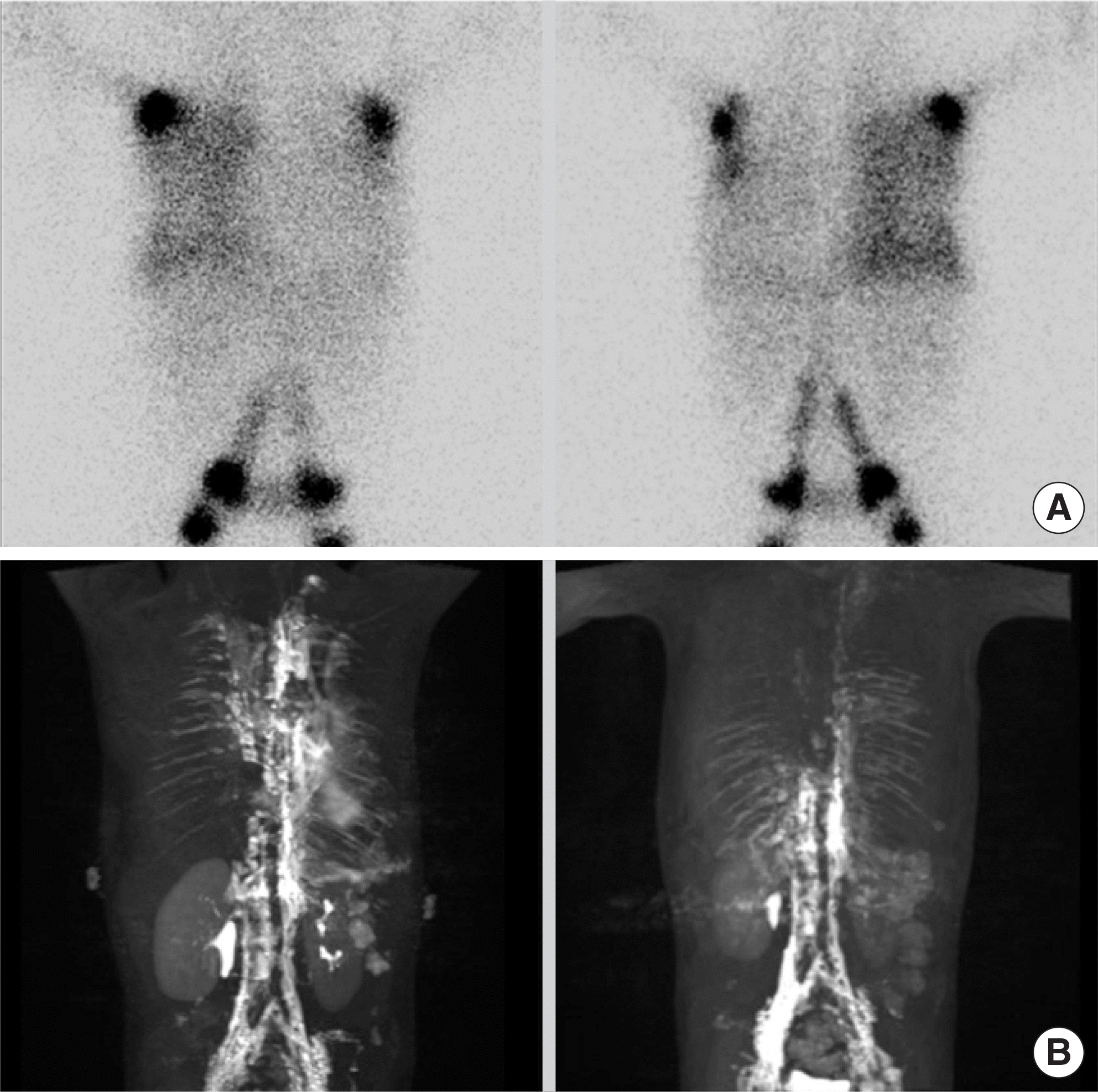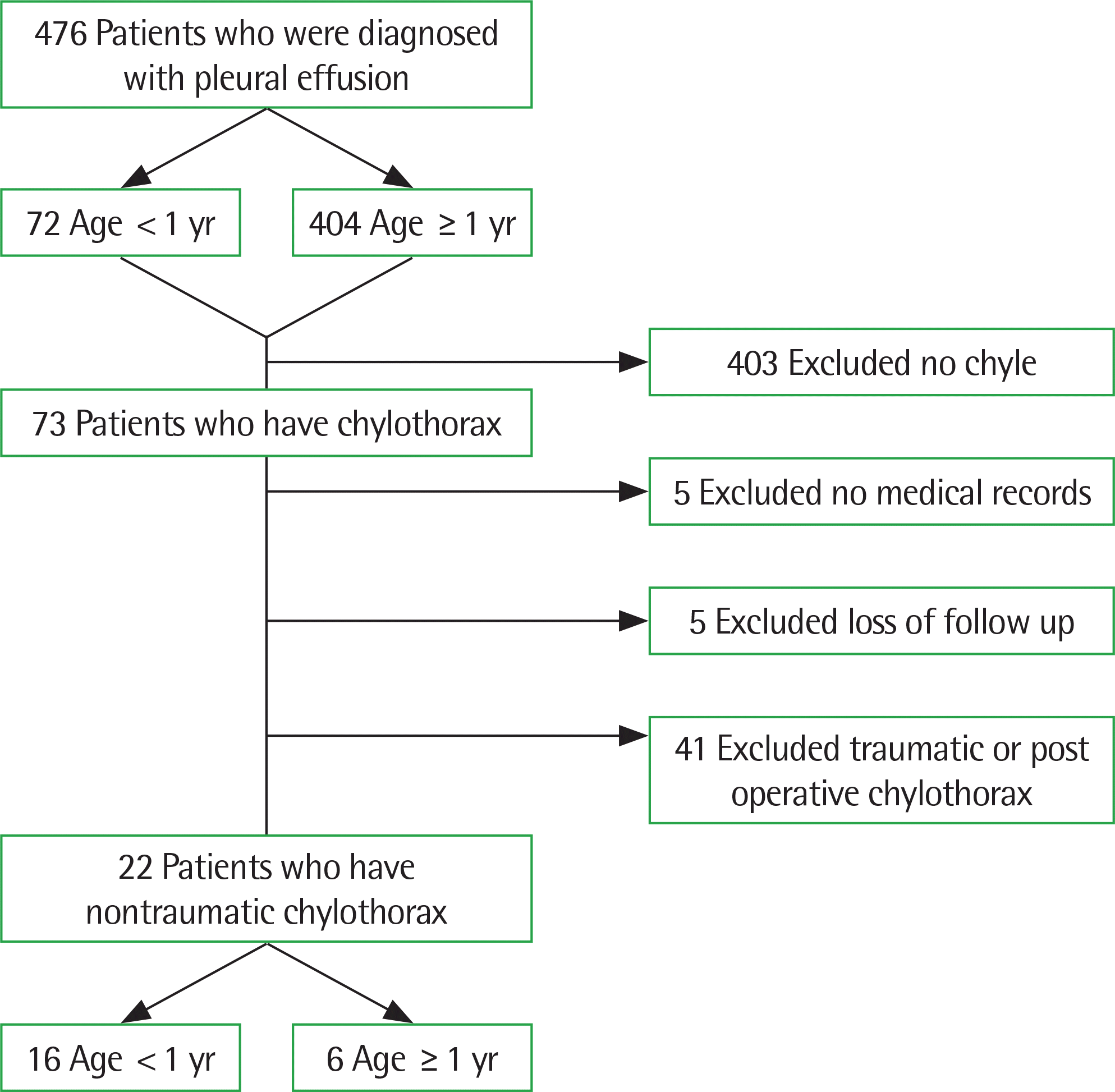1. Light RW. Chylothorax and pseudochylothorax. Light RW, editor. Pleural diseases. 6th ed.Philadelphia (PA): Wolters Kluwer Lippincott Williams and Wilkins;2013.
2. Hillerdal G. Chylothorax and pseudochylothorax. Eur Respir J. 1997; 10:1157–62.

3. Beghetti M, La Scala G, Belli D, Bugmann P, Kalangos A, Le Coultre C. Etiology and management of pediatric chylothorax. J Pediatr. 2000; 136:653–8.

4. Büttiker V, Fanconi S, Burger R. Chylothorax in children: guidelines for diagnosis and management. Chest. 1999; 116:682–7.
5. Romero S. Nontraumatic chylothorax. Curr Opin Pulm Med. 2000; 6:287–91.

6. Soto-Martinez M, Massie J. Chylothorax: diagnosis and management in children. Paediatr Respir Rev. 2009; 10:199–207.

7. Milsom JW, Kron IL, Rheuban KS, Rodgers BM. Chylothorax: an assessment of current surgical management. J Thorac Cardiovasc Surg. 1985; 89:221–7.

8. Panthongviriyakul C, Bines JE. Postoperative chylothorax in children: an evidence-based management algorithm. J Paediatr Child Health. 2008; 44:716–21.

9. Bialkowski A, Poets CF, Franz AR. Erhebungseinheit für seltene pädia-trische Erkrankungen in Deutschland Study Group. Congenital chylothorax: a prospective nationwide epidemiological study in Germany. Arch Dis Child Fetal Neonatal Ed. 2015; 100:F169–72.

10. Wu C, Wang Y, Pan Z, Wu Y, Wang Q, Li Y, et al. Analysis of the etiology and treatment of chylothorax in 119 pediatric patients in a single clinical center. J Pediatr Surg. 2019; 54:1293–7.

11. van Straaten HL, Gerards LJ, Krediet TG. Chylothorax in the neonatal period. Eur J Pediatr. 1993; 152:2–5.

12. Chan DK, Ho NK. Noonan syndrome with spontaneous chylothorax at birth. Aust Paediatr J. 1989; 25:296–8.

13. Van Aerde J, Campbell AN, Smyth JA, Lloyd D, Bryan MH. Spontaneous chylothorax in newborns. Am J Dis Child. 1984; 138:961–4.

14. Rocha G. Pleural effusions in the neonate. Curr Opin Pulm Med. 2007; 13:305–11.

15. Dubin PJ, King IN, Gallagher PG. Congenital chylothorax. Curr Opin Pediatr. 2000; 12:505–9.

16. Tutor JD. Chylothorax in infants and children. Pediatrics. 2014; 133:722–33.

17. Lin CH, Lin WC, Chang JS. Presentations and management of different causes of chylothorax in children: one medical center's experience. Bio-medicine. 2017; 7:30–4.

18. Chernick V, Reed MH. Pneumothorax and chylothorax in the neonatal period. J Pediatr. 1970; 76:624–32.

19. Chen E, Itkin M. Thoracic duct embolization for chylous leaks. Semin Intervent Radiol. 2011; 28:63–74.

20. Chan SY, Lau W, Wong WH, Cheng LC, Chau AK, Cheung YF. Chylothorax in children after congenital heart surgery. Ann Thorac Surg. 2006; 82:1650–6.

21. Cannizzaro V, Frey B, Bernet-Buettiker V. The role of somatostatin in the treatment of persistent chylothorax in children. Eur J Cardiothorac Surg. 2006; 30:49–53.

22. Nguyen DM, Shum-Tim D, Dobell AR, Tchervenkov CI. The management of chylothorax/chylopericardium following pediatric cardiac surgery: a 10-year experience. J Card Surg. 1995; 10(4 Pt 1):302–8.

23. Bernet-Buettiker V, Waldvogel K, Cannizzaro V, Albisetti M. Antithrom-bin activity in children with chylothorax. Eur J Cardiothorac Surg. 2006; 29:406–9.
24. Garty BZ, Levinson AI, Danon YL, Wilmott R, Douglas SD. Lymphocyte subpopulations in children with abnormal lymphatic circulation. J Allergy Clin Immunol. 1989; 84(4 Pt 1):515–20.

25. Kovacikova L, Lakomy M, Skrak P, Cingelova D. Immunologic status in pediatric cardiosurgical patients with chylothorax. Bratisl Lek Listy. 2007; 108:3–6.
26. Mohan H, Paes ML, Haynes S. Use of intravenous immunoglobulins as an adjunct in the conservative management of chylothorax. Paediatr Anaesth. 1999; 9:89–92.

27. Orange JS, Geha RS, Bonilla FA. Acute chylothorax in children: selective retention of memory T cells and natural killer cells. J Pediatr. 2003; 143:243–9.

28. Wasmuth-Pietzuch A, Hansmann M, Bartmann P, Heep A. Congenital chylothorax: lymphopenia and high risk of neonatal infections. Acta Paediatr. 2004; 93:220–4.

29. Zuluaga MT. Chylothorax after surgery for congenital heart disease. Curr Opin Pediatr. 2012; 24:291–4.

30. Mery CM, Moffett BS, Khan MS, Zhang W, Guzmán-Pruneda FA, Fraser CD Jr, et al. Incidence and treatment of chylothorax after cardiac surgery in children: analysis of a large multi-institution database. J Thorac Cardiovasc Surg. 2014; 147:678–86.e1.





 PDF
PDF ePub
ePub Citation
Citation Print
Print



 XML Download
XML Download